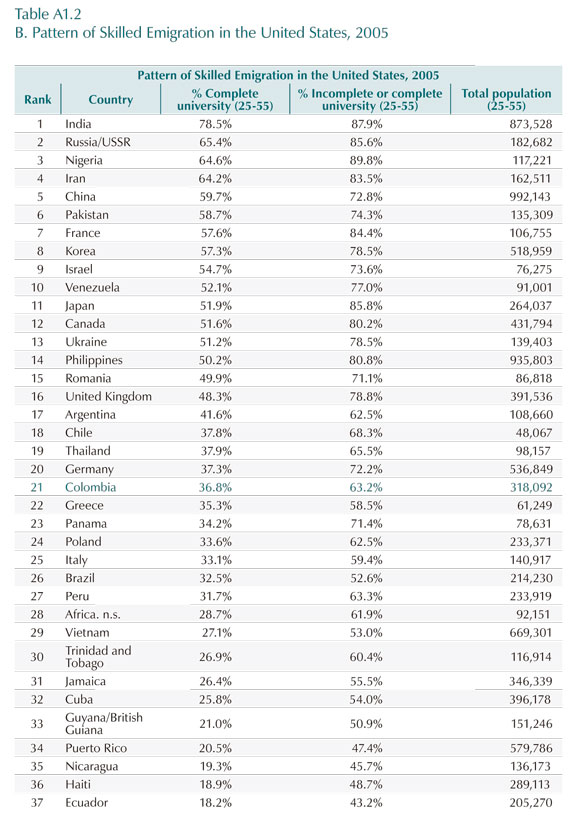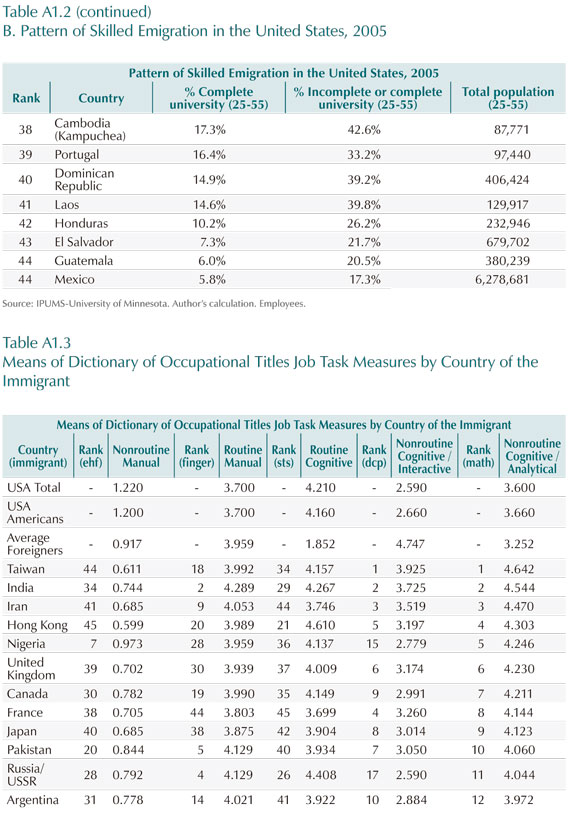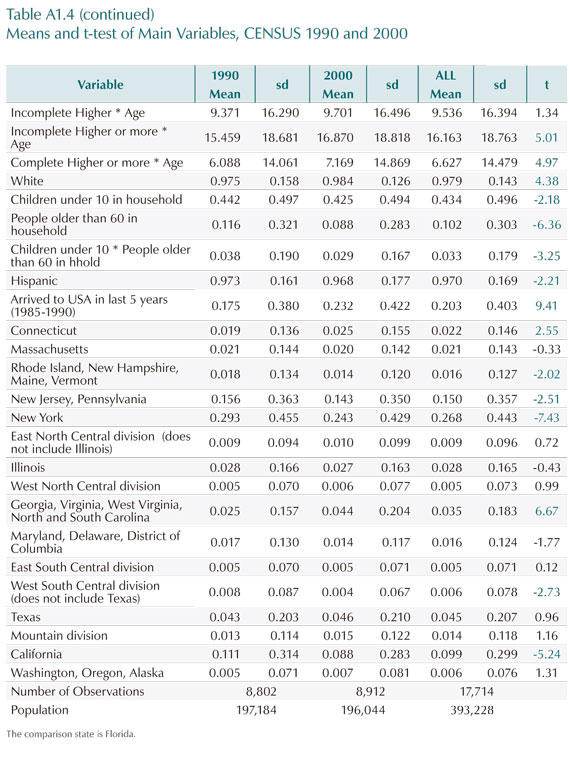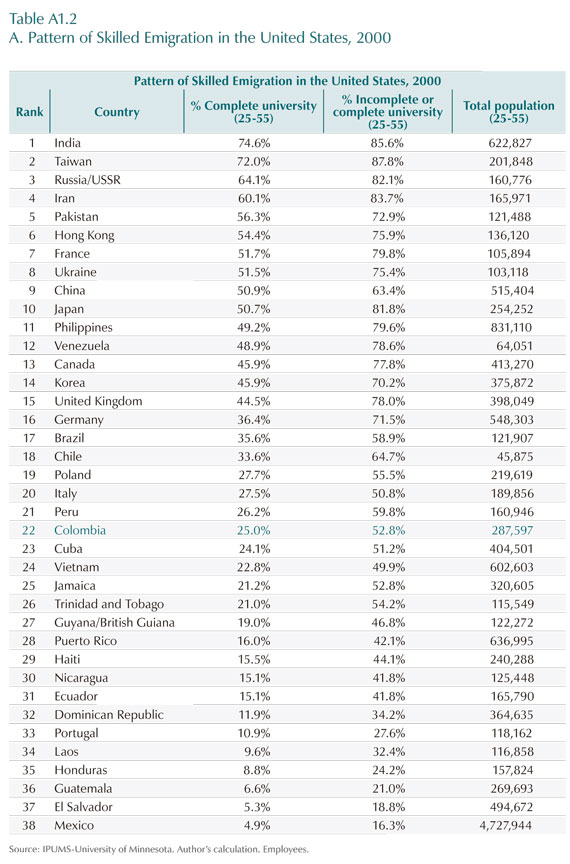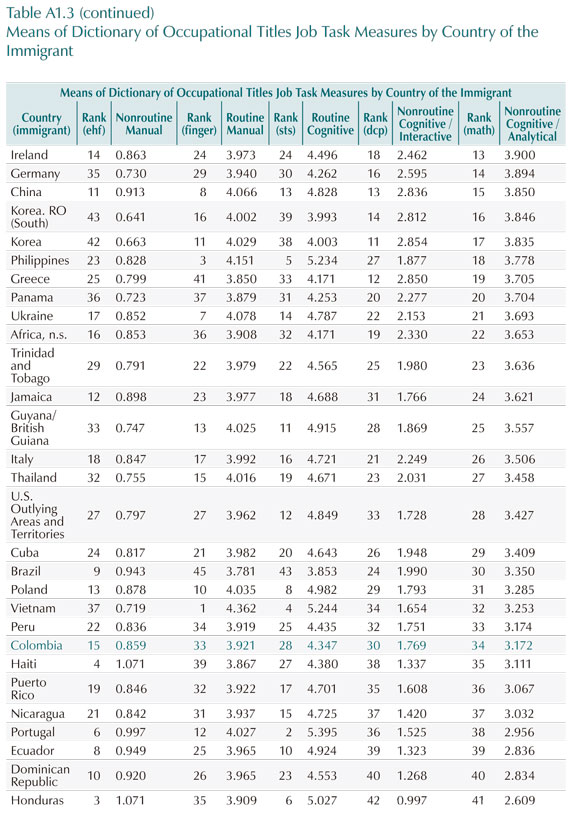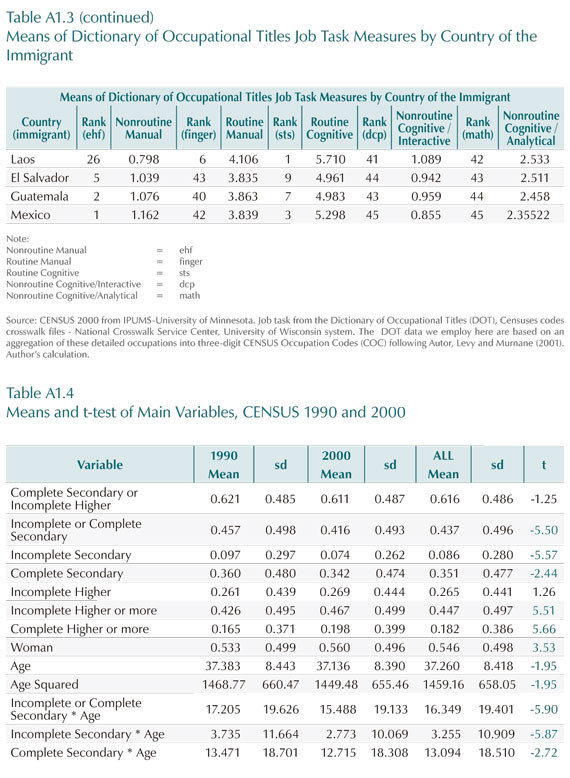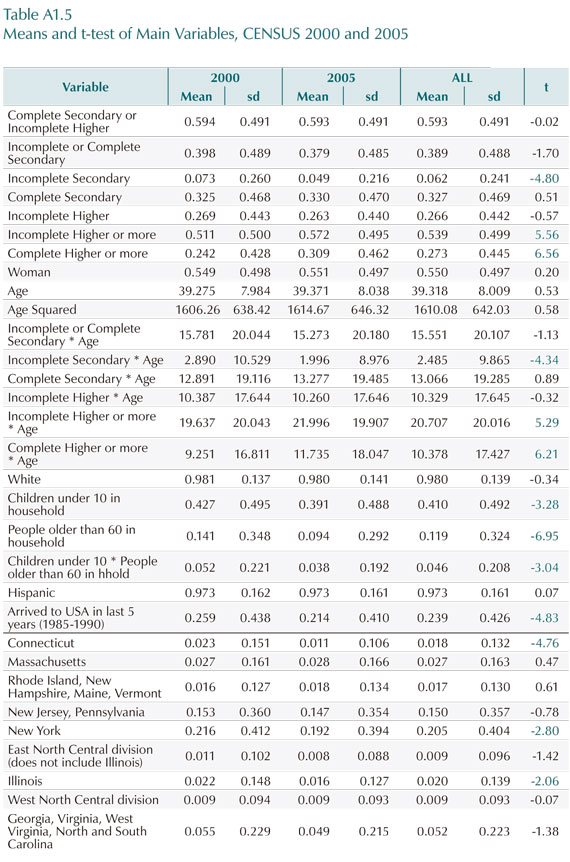Services on Demand
Journal
Article
Indicators
-
 Cited by SciELO
Cited by SciELO -
 Access statistics
Access statistics
Related links
-
 Cited by Google
Cited by Google -
 Similars in
SciELO
Similars in
SciELO -
 Similars in Google
Similars in Google
Share
Ensayos sobre POLÍTICA ECONÓMICA
Print version ISSN 0120-4483
Ens. polit. econ. vol.29 no.65 Bogotá Jan./June 2011
Colombian Immigrants in the United States of America: Education Levels, Job Qualifications and the Decision to Go Back Home*
Inmigrantes colombianos en Estados Unidos: educación, calificación laboral y decisión de retornar*
Imigrantes colombianos nos Estados Unidos: educação, qualificação trabalhista e decisão de retornar*
Carlos Alberto Medina
Christian Manuel Posso
*We would like to thank Alejandro Gaviria, Mauricio Cárdenas, Natalia Millán, and the participants at the Debates de Coyuntura organized by Fedesarrollo in March 2008, and those at the Seminario de Economía sponsored by the Banco de la República in Medellín, for their comments. We are solely responsible for any errors that may appear herein. The opinions expressed herein are those of the authors and not of the Banco de la República de Colombia nor of its Board of Directors.
E-mails: cmedindu@banrep.gov.co; cpossosu@banrep.gov.co
Document received: 30 September 2010; final version accepted: 14 January 2011.
This document shows that Colombian immigrants, who returned to the country from the United States between 1990 and 2005, were on average less well-educated than those who decided to stay in the U.S. This is a fact that has contributed to emphasizing the positive selection made by Colombians when choosing the U.S. as their destination, and, as a result, has increased the net flight of human capital (the so-called brain drain). Although data does not allow us to include the quality of the jobs that immigrants are performing in the U.S. as a determinant of the decision to return, it allows us to show that Colombian immigrants are usually engaged in jobs that require qualifications commensurate with the level of education. We also provide evidence that Colombia is a net exporter of 5% of its population with a university or post-graduate degree.
JEL classification: F20, F22, C49.
Keywords: International migration, returned migrants, task qualification, contamination bias.
Este artículo muestra que los emigrantes colombianos que retornaron al país desde los Estados Unidos entre 1990 y 2005, eran en promedio menos educados que los que decidieron permanecer en ese país. Este hecho ha contribuido a atenuar la selección positiva de colombianos que emigran a ese país, y como resultado, ha aumentado la salida neta de capital humano (la llamada fuga de cerebros). Aunque los datos no permiten incluir la calidad del trabajo que los emigrantes colombianos desempeñan en los Estados Unidos como determinante de la decisión de retornar, sí permiten mostrar que ellos desempeñan usualmente oficios que requieren de habilidades a la altura de su educación. También se presenta evidencia que muestra que Colombia es un exportador neto del 5% de su población con universidad o posgrado.
Clasificación JEL: F20, F22, C49.
Palabras clave: migración internacional, emigrantes retornados, habilidades por tareas, sesgo de contaminación.
Este documento mostra que os emigrantes colombianos que retornaram ao país desde os Estados Unidos entre 1990 e 2005 eram, em média, menos educados que os que decidiram permanecer nesse país. Este fato contribuiu a atenuar a seleção positiva de colombianos que emigram para esse país e, como resultado, aumentou a saída líquida de capital humano (a chamada fuga de cérebros). Embora os dados não permitam incluir a qualidade do trabalho que os emigrantes colombianos desempenham nos Estados Unidos como determinante da decisão de retornar, permitem mostrar que eles desempenham, usualmente, tarefas que requerem de habilidades à altura da sua educação. Também se apresenta evidência que mostra que a Colômbia é um exportador claro de 5% da sua população com estudos universitários ou pós-graduação.
Classificação JEL: F20, F22, C49.
Palavras chave: migração internacional, emigrantes retornados, habilidades por tarefas, viés de contaminação.
I. INTRODUCTION
It is estimated that at the present time over three million Colombians are living abroad. In the year 2005, it was estimated that around one million of these Colombians were living in the United States, along with 2.23 million immigrants from South American countries1. It is fundamental to study the evolution of migratory tendencies among those countries in the region from which people are migrating, so that their governments can design long-term development policies that can be implemented in the light of these tendencies and which, if called for, can have an impact on these tendencies, in accordance with the objectives laid out for each particular country.
Nonetheless, governments need to understand the factors that determine migrants' decisions to either remain in their adopted country or return home, in order to be able to draw up adequate policies on the matter. Also, a better understanding of migrants' decisions can be important for people who are living in their home country, but are considering the possibility of migrating to another country. It can help them make their decision based on full and unbiased knowledge- something they usually lack. Such is the case of a potential emigrant who decides to emigrate (or not) without having an idea of his (or her) chances of success in the country to which he (or she) intends to migrate, since he (or she) does not know why a migrant may eventually decide to come back home.
This document adopts standard methodology on the theory of evaluation of social programs and has selected a model that enables us to establish the main factors which determine the decision to stay in the United States on the part of Colombian migrants living there. In particular, our exercise shows that those who are university graduates or post-graduates have a 22.6% greater probability of remaining in the U.S than those with secondary education or less. The results of this model provide evidence that those Colombian migrants who left the United States and returned to Colombia between the years 1990 and 2005 are, on average, less well- educated than those who decided to stay in the U.S. This pattern has contributed to intensifying the selection process, which characterized the initial migratory influx, i.e., the "positive selection", and hence, the net flight of human capital (brain drain).
In order to better understand what motivates migrants to remain in the United States, we proceed to explore the relation which exists between the migrants' levels of education and the level of complexity of the tasks which these same migrants find in their jobs or places of employment. To carry out this exercise, we used the classification of occupations established by Autor, Levy and Murnane (2003). The results reveal that in the case of Colombia, the migrants' levels of education are closely linked to the level of qualification required of them for the work they do in the United States, from which we deduce that the popular belief that Colombian professionals who work in the United States are employed in jobs that require little qualification would seem to be no more than a myth.
The evidence provided in this article, along with the results of previous studies, suggests that the Colombian migrants' option to remain in the United States is more a matter of being capable of making that decision, rather than simply wanting to do so. Those who stay, because they prefer to do so, would seem to be the ones who have managed to be better assimilated in the United States, and that is generally related to their degree of qualification which enables them to remain in their country of adoption while enjoying an adequate lifestyle.
In what follows, we will proceed to describe some elements of the background on this subject before presenting, in stylized form, the main characteristics of Colombian immigrants' cases. Later, we describe the methodology employed to estimate the factors which determine Colombians' decision to return, and present and discuss the results of these estimates. Following this, we carry out an exercise intended to determine the relation between educational levels and qualification for the migrants' tasks in their adopted country, and finally, we present some conclusions.
II. BACKGROUND
At the present time, the developed countries have shown a growing interest in promoting the return of migrants to their home countries. This concern is also on the agenda of several medium income countries from which the migrants have originally come -India, China, Brazil-, as well as Colombia.
Thanks to experience gained during their period of migration, the returnees will have acquired general and specific skills which can contribute to the development of their home countries. There is special interest in drawing back the highest qualified citizens that had decided to migrate, -thus having given rise to the so-called "brain drain"-. Some countries are interested in capitalizing on the abilities which such individuals have developed during their time in developed countries, and want to take advantage of the benefits of what they now call "brain gain". One such example is India:
Indian politicians are beginning to highlight, approvingly, the emerging phenomenon of ‘brain gain', as large numbers of Indian-born executives decide that job opportunities and living conditions are as good, if not better, in India and make their way home. Between 1964 and 2001 (when the economy was sluggish), 35 per cent of the nation's most promising graduates moved abroad … but from 2002 onwards (the period when India's GDP began to soar) only 16 per cent chose to leave. (The Guardian, 2008, observed on April 4, 2009).
Several theories exist on the reasons that lead migrants to return home, as well as on other matters, such as the profile of the returnees, and the moment when they return, Cassarino (2004) sums up several of the theories expounded on up to now; among which, we find the approximations of the Neo-classical School of Economics, (NE) the New Economy on Labor Migration (NELM), Structural Approximation, Transnationalism and the "Social Networks" theory.
According to the NE approximation, those who migrate do so, for an indefinite period of time, as a life project. In this sense, the return home will occur, only, as the consequence of a failed migratory experience. On the other hand, NELM suggests that the decision to return home is a logical step in a previously calculated strategy, since it assumes a return to be the culmination of a migration project. Structural Approximation suggests that to analyze a migrant's return, we should bear in mind not only his (or her) personal experience, but also the social and institutional factors that are present in his (or her) home country. Thus, the decision to return is also a question of context (Cassarino, 2004), especially the economic and social context of the home country and that of the country to which he (or she) had decided to migrate.
For Transnationalism, the return home is not necessarily permanent. It occurs once the individual has obtained sufficient resources to guarantee the sustenance of his (or her) family, and when the conditions of the home country are favorable. Later, the individual will look for a way to return to the country to which he (she) migrated in the first place in order to take advantage of the relationships which he (she) has created there. Thus there will be a permanent migratory flux between the home country and the country in which he (or she) has established different ties. Finally, the "Social Network" theory sees the returnees as migrants who establish strong ties in other countries. However, what this focus considers relevant are those relationships which will contribute to their future initiatives or projects in their home countries. In this sense, the decision to return is programmed, and depends on the economic and social ties which the migrant has managed to establish to support his (her) projects in the home country.
The United States Bureau of the Census, based on previous studies by Warren and Peck (1980) and Warren and Passel (1987), estimates that the exodus of international migrants from the United States is, in the Latin American region, about 133,000 people per annum. Ahmed and Robinson (1994) developed a method for bringing these estimates up to date and showed that this figure could be 47% higher, and that it was probably nearer to 195,000 people per annum for the 1990´s.
Borjas and Bratsberg (1996) estimated the rate of emigration (out-migration) of foreigners leaving the United States at approximately 17.5% during the period 1975-1980 and 21.5% during the period 1970-1974. In the case of Colombia, 24.7% of all Colombian immigrants left during the period 1975-1980, and 17% between the years 1970 and 19742. That is to say, during the period 1975-1980, approximately 46.136 Colombians emigrated from the United States; while during the period 1970-1974, some 28.254 had done likewise. Borjas and Bratsberg (1996) also showed that when comparison is made with migrants from countries from Central and South America and the Caribbean. Colombians are one of the groups with the greatest number of returnees (surpassed only by Mexico, the Dominican Republic and Jamaica).
Borjas and Bratsberg (1996) found evidence that shows that the decision to return home intensifies the selection which characterized the initial migratory influx. This means that in those countries where the initial migration was brought about by a "positive selection" (where the emigrants were on average better -educated- as is the case for Colombia), they observed that those migrants who returned were on average the less well- educated. And the opposite also occurs: in those countries where the migratory flux was characterized by a negative selection, they found that the migrants who returned were, on average, better- educated.
Governments of countries with a high rate of emigration are interested in finding out whether or not part of the human capital which left the country in earlier periods can be reintegrated into the country's society and so, at least to some extent, turn back the "brain drain"3. Besides, qualified migrants are able to absorb technologies (which in many cases are intangible) and skills that can be used to the advantage of their country of origin. This process, designed to revert the "brain drain", can enable those who have migrated to other countries to generate external values for their home countries and makes up part of what is known as the "brain gain".
Now, all depends on whether what exists is positive selection or, the contrary, negative selection (Borjas and Bratsberg, 1996), If the selection is positive, then the returnees will be lower, on average, among the less educated, which means that the effects of the "brain gain" will not be an advantage for the home country, but rather the "brain drain" effect will be augmented. If, on the other hand, the selection is negative, then the returnees will be, on average, the best educated among the migrants, and that will probably lead to a "brain gain" and the consequent advantage to the home country to which the migrant has returned, reverting to some extent the "brain drain" process.
III. STYLIZED FACTS
The International Organization for Migration (IOM) estimates that in the year 2008 there were over 200 million migrants scattered around the world, and that the amount of money being sent back to relatives in their home countries was in excess of US$337,000 million. In 2005, the region which had the greatest flow of international migrants was Europe, with 64.1 million people, while Latin America had 6 million. The principal receiver countries for international migrants are the United States, the Russian Federation, Germany, the Ukraine and France. The country with the greatest influx of Colombian immigrants is precisely the United States, with approximately 35% of the total number. Now, we want to answer some general questions that will allow us to draw our baseline: (1) How many Colombians are living abroad?; (2) What are the Qualifications of Colombian Emigrants?; (3) How are the Labor Conditions of Foreigners in the United States?, and (4) What are the main characteristics of Emigrants who leave the U.S. and return to Colombia?
A. HOW MANY COLOMBIAN ARE LIVING ABROAD?
Regarding the number of Colombians living abroad. the authors are in disagreement. Cárdenas and Mejía (2006), based on statistics supplied by Colombia's Security Department (DAS), estimated that between 1996 and 2005 the net number of Colombians who left the country, on average, amounted to 174,000 people per annum. Over this entire period, a total of 1.9 million Colombians emigrated. The authors quote figures from Colombia's Foreign Affairs Ministry based on population censuses carried out in different countries which reveal that, in the year 2000, the total number of Colombians living in the countries surveyed was 1.92 million. In the same year, other relevant destinations for Colombians were Ecuador (51,556 people in 2000), Panama (21,080), Canada (18,472), Italy (16,398) France (13,116) and the United Kingdom (12,331), among others. Also, according to the census taken in Colombia in 2005, 3.3 million Colombians were living abroad at that time; in other words, 8.1% of the country's entire population.
As mentioned above. the United States is not only the country which hosts the greatest number of international immigrants; it is also the country which receives most Colombians. In 2005, there were approximately 566,000 Colombians in the U.S.A.; that is 45 times more than in 1960, 9 times more than in 1970, 4 times more than in 1980 and 1.9 times more than in 1990 (See Table 1 appendix). However, Gaviria (2004) estimated that the number of Colombians in the United States in the year 2000 was nearly 700,000, while Cárdenas and Mejía (2006) estimated the number at 1,175,881 in 20054.
A simple estimate would enable us to accept as reasonable a figure somewhere between the calculations of the Foreign Affairs Ministry and those of Gaviria (2004): (i) the Colombian population as represented in the U.S. Census taken in 2000 showed that some 306,000 Colombians had been living in the United States for at least ten years; (ii) between the years 2000 and 2005, approximately 62,000 Colombians left the United States, in which case, if a similar rate of influx of Colombians occurred between the years 1990 and 2000, over that ten-year period some 124,000 Colombians had back arrived in the country (see table 1). Supposing this to be correct, the 303,000 Colombians registered in the 1990 U.S. Census did not take into account a further 124,000 Colombians, or thereabouts, giving a grand total of 427,000 Colombians in the U.S. in 1990. If the Colombian population in the United States increased at an annual rate of 5.5%, as indicated in the census of Colombians taken over those years (taking into account the same ratio of people not covered by previous censuses), we would have a total of approximately 696,000 Colombians in the United States in the year 2000; and nearly 890,000 in 2005.
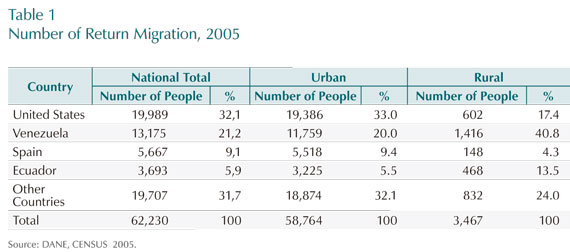
As shown in Table 1, Appendix, based on figures from U.S. censuses, Colombia is eighth among Latin America countries with the greatest number of immigrants in the United States (in 1990 and 2000, it was seventh). The countries whose numbers exceed Colombia´s are: Mexico, Puerto Rico, El Salvador, Cuba. the Dominican Republic, Guatemala and Jamaica. The countries with the highest growth rate of immigrants in the U.S. from 1990 to 2000, and from 2000 to 2005, are Brazil, Honduras and Venezuela. The number of Colombian immigrants increases at a medium rate in comparison with that of other Latin American countries.
B. WHAT ARE THE QUALIFICATIONS OF COLOMBIAN EMIGRANTS?
In the Colombian case, one of the most notable facts related to the overall profile of the resident population in the United States is that Colombians in the U.S. are generally better- educated than those who have remained at home. The information of CENSUS 2005 for U.S. and Colombia shows that Colombians between the ages of 25 and 55 who live in the United States are more highly qualified than those who live in Colombia5. Around 37% of Colombian immigrants in the U.S. have completed university degrees or more, while only 14% of Colombians residing at home have obtained a similar degree of education. Likewise, some 3% of Colombians between 25 and 55 years of age in the U.S., in 2005, had a level of primary schooling or less; while in Colombia, 42% of the population remains in that category.
On the other hand, Garay and Rodríguez (2005) showed that 70.5% of Colombian emigrants who send money back to relatives from Spain and the United States have completed secondary education or higher; whereas, in the case of the recipients, only 58.6% have (in the U.S., 62%; in Spain, 50%). The authors consider this result indicative of the lower socioeconomic status of the families whose members have migrated to Spain, when compared to those who have migrated to the U.S.
In general terms, the qualifications of the average Colombian who migrates to the United States are more likely to be higher than those of the average Colombian who stays at home. That is to say, Colombia is a net exporter of skilled people; in particular, Medina and Posso (2009) found that Colombia is a net exporter of skilled individuals -since the net exportation of skilled people is 5.4% of the total number of educated Colombians who l live in Colombia-. Also, they showed that Brazil, Argentina and Chile are net importers (see Graph 1).
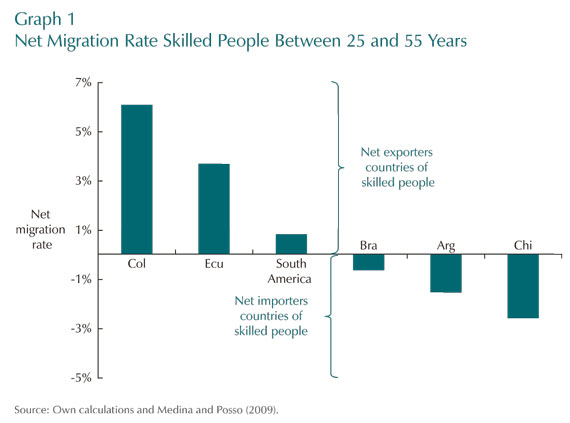
This implies that, at least at some particular moment, there existed what Borjas (1987) and Borjas (1994) would call "positive selection", in accordance with the fact that those who leave a country are better- educated. Despite this, it is equally important to know whether those Colombians who return home from abroad are more or less well- educated than those who remain in their adopted countries. If we establish that not only are the Colombian emigrants better -educated, but also that they are the ones who will probably remain abroad and not return, and that their absence from Colombia is not compensated by the entry of foreigners into Colombia, then we will have evidence to show that the country has been experiencing an overall loss of qualified personnel -the so-called "brain drain"-.
C. HOW ARE THE LABOR CONDITIONS OF FOREIGNERS IN THE UNITED STATES?
We might validly wonder whether or not a higher degree of education has contributed to the fact that well- educated migrants enjoy a higher standard of living in their adopted country, and to what extent that has determined their decision to stay abroad. This query arises from the abundant anecdotes and stories told by the numerous professionals who have migrated to the United States and who are employed in jobs for which their academic qualifications are not required. The following press release illustrates the point:
According to the most recent official census of New York City, of a total of 162,120 Colombian workers, both legal and illegal, 3,994 are at present engaged in subsistence employment, working in jobs that have nothing to do with their original professions in Colombia. The number has increased due to the constant influx of professionals from Colombia entering the United States (…) and according to a recent report by the Organization for Cooperation and Economic Development entitled International Migration Perspective 2007, an average of 30.6% of Colombian migrants worldwide are overqualified for their jobs (…) There are more and more surgeons, lawyers and engineers from other countries who make their living driving taxis, selling hot dogs or working on building sites in search of the American Dream. And the majority of them are here in New York6.
Let us begin by reporting the distribution of the overall human capital in the United States. For the year 2000, the OECD estimated that 34.6% of the total number of migrants was made up of qualified people, and that 50% of them were located in the United States. The Appendix (see Tables 2A and 2B) shows the percentage of qualified people in the U.S., by country of origin, for the years 2000 and 20057. The countries with the greatest proportion of people, with at least complete university level education, are India, the Russian Federation, Iran and Taiwan. As for Latin America's place at this level, the most notable countries in 2000 were Brazil, Chile, Peru, Colombia and Cuba. However, by 2000 the countries with the greatest number of well qualified people who were migrating were India (9.5% of the total), the Philippines (8.4%), China (5.4%), Mexico (4.8%) and Germany (4.1%). Colombia participates with 1.5%.
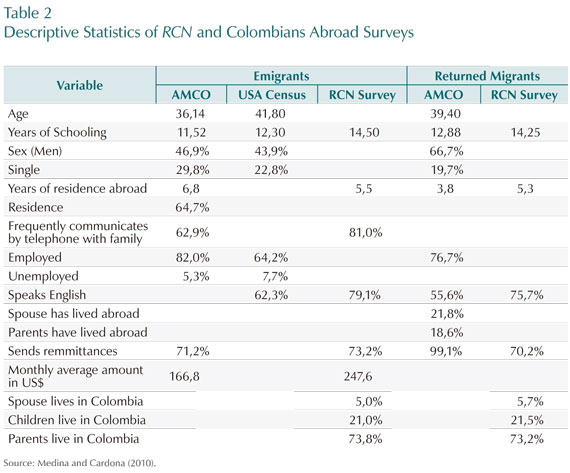
To determine what jobs are being done by foreigners working in the United States. we use information provided by Autor et al., (2003). ALM, who defined the levels of intensity of each kind of employment in five kinds of tasks -two of which are analytical (that is, they require analysis and quantitative abilities)-, two are routine (that is, they require precision and can often by computerized), and one is manual (not able to be computerized)8.
Table 3, in the Appendix, shows the principal areas in which foreigners in the United States are working9. Immigrants from countries like Taiwan, India, Iran, Hong Kong, Nigeria, the United Kingdom, Canada, France and Japan are, on average, those whose presence is most intense in analytical tasks such as planning and/or direction. Also, as shown earlier, these tend to be the countries with the greatest number of qualified personnel who have migrated. The information above is clear proof of the "brain drain" in these countries, the migrants are not only highly qualified (on average) but also tend to develop tasks with a high analytical component, such as planning and/or direction - tasks which probably have to do with their original professions.
However, not all countries tell the same story. Migrants arriving from Mexico, Guatemala, Honduras, Haiti, El Salvador, Portugal, Puerto Rico, Nicaragua, Ecuador, the Dominican Republic and Laos are immigrants whose average work consists of manual or manual-routine jobs. That is to say, quite apart from their level of qualification, these immigrants tend to be employed in tasks with a high manual labor component, such as housecleaning, driving, wait service, and so forth. In other words, they usually do jobs with a minimum level of analytical component. Also, in the case of Latin America, Graph 2 shows that migrants from countries with high levels in analytical tasks have less intensity in manual tasks.
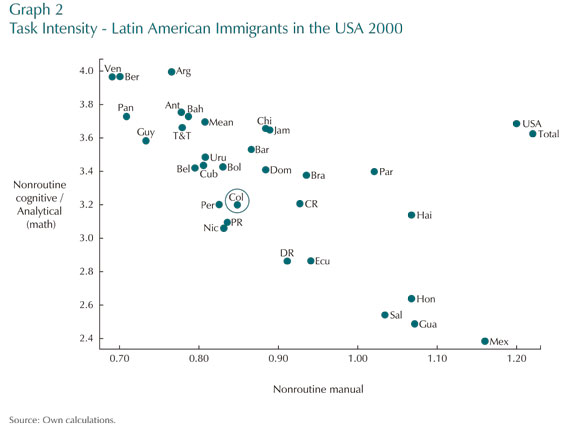
Colombia is number 15 in the manual labor category, number 33 when it comes to manual-routine jobs, 28 in the field of cognitive-routine work, 30 in planning and directional tasks and 34 in the analytical area.10 While it is true that there is a significant leakage of well qualified people from Colombia, on average, Colombians are mostly employed in jobs with a high routine-manual component; as to what occurs with other migrants, such as those from India, the Philippines. Taiwan or Hong Kong, for whom the above results would not permit us to play down the evidence from the anecdotes which we mentioned above.
D. WHAT ARE THE MAIN CHARACTERISTICS OF EMIGRANTS WHO LEAVE THE U.S. AND RETURN TO COLOMBIA?
Several articles on Colombia have provided ideas on the profile of those who decide to return home. Table 2 shows that, according to surveys taken by the RCN radio station (Radio Cadena Nacional) and Colombians Abroad (Colombianos en el Exterior11), those migrants who remain abroad are slightly better- educated than those who come back -which would indicate a "positive selection" of migration as propounded by Borjas and Bratsberg (1996).
However, according to the AMCO survey12, migrants abroad have approximately 11.5 years of education, while those returning have had approximately 12.9 years of similar formal education. Thus the results obtained by RCN and AMCO would seem to contradict one another. This could be due, on the one hand, as mentioned by Medina (2008), to the fact that AMCO carried out a haphazard survey of people in Pereira with an experience of migration. whereas RCN allowed the better- educated members of the population to make their own pre-selection. Also, there is the fact that the RCN survey did not include those Colombians who have migrated with their entire families. If those who migrate with their families prove to be better- educated on average than those who return. then the AMCO survey will have overestimated the educational level of those returning.
The descriptive statistics provided in the appendix show that if one relies on figures taken from the American censuses of 1990, 2000 and 2005, it will be found that, during the period from 1990 to 2005. Colombians returning home were relatively less educated than those who remained in the United States. The tables which compare the medium variables employed later on in an empirical exercise, present, in the last column, a statistic to prove the significance of the differences between averages in the year 2000 (2005) and those in 1990 (2000) (See Tables 4 and 5 from the Appendix). On the other hand, the tables suggest that, although it was less probable that from 1990 to 2000 more women returned than men, between the years 2000 and 2005 there is no difference recorded based on gender. The tables also show that from 1990 to 2000 those who were more likely to return home were older people- non-whites, non-Hispanics, people who had spent more than 59 years in a household, who did not have children under ten years of age, and who had been living in the U.S. for over five years (results consistent with our estimations).
Gaviria and Mejía (2006), using information from the RCN survey, noted that the desire to return stems from three factors: (1) the circumstances which originally led to migration, (2) the existence of family or social ties in the home country, and (3) the migrant's lack of adaptation to the receiver country. On the first point, the authors found that the most important factor determining the desire to return is an improvement in the perspectives of economic activity, as well as security and employment. Among the factors associated with the second point, the authors mention that the desire to return is greater for those who have a husband or wife in Colombia. Finally, among problems of adaptation they mentioned language and low educational levels; in particular, they explained that there is a greater desire to return among high school graduates than among professionals. The last results are in accordance with the "positive selection" category; that is, the better qualified remain abroad13.
Medina (2008), using statistics from the U.S. censuses of 1990 and 2000, designs a logit model to identify the determining factors in the probability of returning: defined as the probability that those people who were in the United States in 1990 had returned to Colombia by the year 2000. The author found that probably more men than women have returned, as well as the less educated (those with incomplete university education or less), those over age 55, whites, Hispanics, those without children under age ten to be cared for, and those who had been living in the U.S. for over five years (that is, between the years 1986 and 1990). He also found that the most likely to return were Colombians who had been living in the States of Alabama, California, Washington D.C., Illinois, Louisiana, Maryland, Massachusetts, Michigan, New Jersey, New Mexico, New York, Rhode Island, Texas and Utah; but not those who were living in Florida, Georgia, South Carolina or North Carolina.
Notwithstanding the consistency of several of these results when compared with the descriptive statistics estimated on the basis of the U.S. censuses, the results of the exercise are affected by a phenomenon known in the literature on the evaluation of social programs as the "contamination bias" (Heckman and Robb, 1985). In what follows we develop a calculation of the probability of not returning from the United States using a methodology which enables us to correct this bias, thus allowing us to infer the determining factors in the decision to return on the part of Colombians residing in the U.S. during the periods being studied.
IV. THE DETERMINING FACTORS IN THE PROBABILITY OF RETURNING OR STAYING IN THE U.S.
Our document presents evidence on two important questions: (1) What are the characteristics (especially the education levels) of Colombian immigrants in the United States that determine the probability of their taking up permanent residence in that country?, and (2) How well do the occupations of Colombian immigrants in the United States match the skills and education levels of those immigrants? Specifically, we want to know the following: Are educated migrants working in low-skilled occupations that do not fully use their skills? In this section, we deal with the first question. In the next section, we will answer the second.
Our main goal in this section is to find the main determinants for the probability of return to Colombia, or the probability of stayingin the U.S. Our exercise includes several control variables, but the level of education of Colombians is the most important variable for our exercise. The general model has the following expression14:

Where:
Y is equal to one if the individual remains in the U.S. and does not return to Colombia.
Edui is the educational level of the individual: includes primary, secondary and university level with both complete and incomplete degrees.
Controls: includes variables like gender, age, race, children under 10 years in household, people older than 60 years in household, an indicator variable that shows whether the individual arrived in the U.S. in the last five years, and states fixed effects.
Another possible control is the task intensity. Nonetheless, since we do not have information regarding the tasks Colombian migrants (described in the 2000 U.S. census) were performing in 1990, we cannot use that information as an additional control variable in our empirical model of return migration. In addition, if it were available, it would require a different methodology, since people self-select into different tasks, which would thus produce an endogenous variable.15
For this estimation we use U.S. CENSUS data for the years 1990, 2000 and 2005 16. Nonetheless, we have to deal with the problem of contamination bias. The next section presents the solution for this problem developed by Heckman and Robb (1985).
A. CONTAMINATION BIAS: METHODOLOGY
The problem of contamination bias is brought about by the fact that available information does not enable us to distinguish between the population that is the subject of our study and that which is not its subject. In order to assess the factors which determine the decision to return, we need to know the characteristics of those who did return and of those who remained in the United States; that is, their characteristics previous to the moment when they made the decision to return, or otherwise.
In general, we could have three possible samples of the population under study (following Heckman and Robb, 1985):
Sample (i): The endogenous variable and covariates of those Colombians who decided to stay in the U.S.
Sample (ii): The endogenous variable and covariates of those Colombians who decided to return.
Sample (iii): The endogenous variable and covariates of those Colombians whose status is not known.
In our specific case, when we analyze the period between 1990 and 2000, we need to know what the characteristics were, in the year 2000, of those Colombians who decided to stay in the U.S. (which we shall call Sample (i), following the notation of Heckman and Robb, 1985). However, with the information available in the U.S. CENSUS 1990 (which we shall call Sample (iii)), it is not possible to establish those Colombians who finally did decide to return to their home country17, and those who decided to stay in the U.S. in 2000 (in other words their status is unknown).
Except in some very special cases, as for example cases in which the decision to return was taken by a random subset of the population, estimations such as those of Medina (2008) produce results that do not correspond to the parameters that interest us, since they implicitly assume that the whole population studied in 1990 was made up of people who did, in fact, return.
In our exercise, we will confine ourselves to information about Colombian residents in the United States in 1990, who at that time were between 25 and 55 years of age, and residents in the year 2000 who were between 35 and 65 at that time and had been living in the U.S. for at least ten years. By choosing this population range we avoid two kinds of bias. On the one hand, given that the census of people in the year 2000 does not ask retrospective questions (that is, questions about the past), and that we need information about those people as they were in 1990, we must use variables about them that cannot have undergone change between the years 1990 and 2000. Bearing in mind that the level of education of Colombians in 1990 is the most important variable for our exercise, the inclusion of that factor in the case of young people observed in the year 1990 does not allow us to presume with any degree of reliability that the educational level of those who studied in 2000 is the same as that of those we are looking at ten years earlier.
On the other hand, the fact that we include people over 55 years of age, would lead to a greater probability that, by the year 2000, many of them would no longer be alive; thus, weakening the significance of the data along with the respective bias deriving from this very information.
Heckman and Robb (1985) propose a simple formula for correcting this contamination bias. In our case, we would start from a standard model, like Equation (1), in which the result Y, in this case the decision to remain in the United States (where Y is 0 if the person returns home and 1 if the person remains in the U.S.), is explained by a group of control variables X, and a haphazard termination U:

Based on some simple suppositions, among which are included18:

and knowing that from Sample (iii), that is, from the 1990 census, it is possible to generate the following product crossed with I(iii) observations:

which, under certain conditions of state, converge with the desired population-oriented counterparts. Now, note that if the decision to stay in U.S. were observed, then:

Where p is the proportionate number of Colombians who remain in the United States, which we can infer on the basis of the 1990 and 2000 censuses, and from which we deduce the proportion of those who remained in the U.S. in the year 2000.
Given the above scheme, for purposes of our exercise the so-called contamination bias can be corrected by Equation (5) using the information of Equations (3) and (4) (where Y0 = 0 is the person who returns home and Y1 = 1 is the person who remains in the U.S.)19:
Where:

As mentioned previously, the population included in the exercise will be a population that was in the United States in 1990 and was still there in the year 2000. It is worth underlining the fact that, to arrive at the final bases, age (and other variables which require it) will be assessed on what it is assumed was their value in the year 1990. For example, when we need to construct the variable of the number of children under ten years of age for the population in 1990, we will look at the variables of the number of those under age 19 in the year 2000. In order to verify the sensitivity of the results, especially those related to education, we develop an alternative exercise for those members of the population who were between the ages of 35 and 55 in 1990, getting the same results.
A preliminary exercise is carried out on the period from 1990 to the year 2000. Nonetheless. IPUMS has made available a CENSUS sample of 1% of the population in the United States in the year 2005. On the basis of this information we can carry out an exercise similar to the one detailed above. but with information from the years 2000 to 2005 (in which case the information will be standardized to the year 2000).
Several assumptions are implicit in the approach outlined above, among which are those that highlight the fact that if the U.S. census did not include a representative sample of the whole Colombian population in that country, in one of the years (maybe because illegal Colombians did not show up on the interview day), then inferences would only be applicable to the sample of Colombians included in the census; taking into account that in the other year used in the estimation, the source of bias did not change.
B. RESULTS FOR COLOMBIA
The following results intend to establish the factors determining the decision to remain in the United States on the part of Colombian immigrants, especially in that particular aspect which pertains to the part played by educational levels when making a decision.
We showed above that the rate of migration by Colombians to the United States (Borjas and Bratsberg, 1996) was approximately 24.7% (46,136 Colombians) for the period 1975-1980; whereas, for the period 1970-1974, it was approximately 17% (28,254 Colombians). Medina and Cardona (2006) showed that the net rate of migration reaches a maximum in the year 1999 and from then on begins to descend until the year 200320. which indicates a behavioral pattern of Colombians returning home. Gaviria and Mejía (2006) show that, for the RCN survey, 65% of those queried desired to return or had contemplated returning to their home country, which implies a subjective indication of the behavioral pattern of those who did return.
In an attempt to establish the determining factors for remaining in the United States on the part of Colombian migrants, we designed a model on the lines of the methodology described above. As our baseline scenario, we estimate a standard OLS model 21 which is affected by the contamination bias, similar to that estimated by Medina (2008), and its results are presented in Table 3 22. Later, the models were estimated correcting the contamination bias, adhering to proposals made by Heckman and Robb (1985), and presented in the methodology in Equation (5).
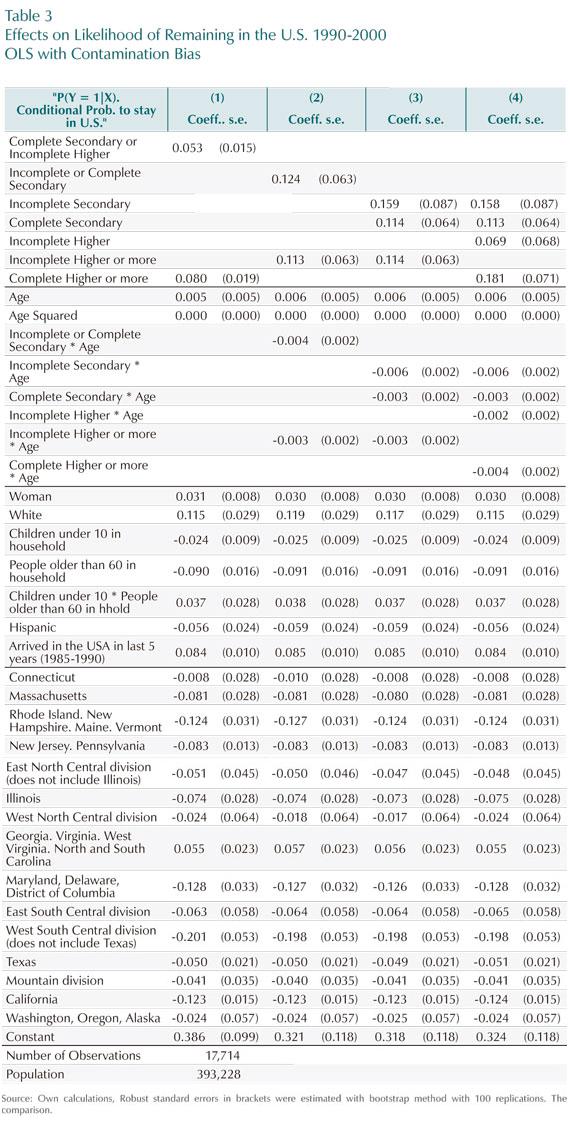
According to the model presented in Table 3, Colombians who have completed secondary level education, or have taken university courses, but without graduating, are 5.3% more likely to stay on in the United States than those with an incomplete secondary education or less; while Colombians who have graduated from university, or have an even higher level of education, are 8% more likely to remain in the U.S. To measure the education factor in this regard, we designed a model for the population between the ages of 35 and 55.
Table 4 presents the results once we have corrected the contamination bias (Equation (5)), The results for 1990-2000 provide evidence to suggest that the better- educated Colombians stay on in the United States. The significance of the effect is the same, for the biased regression and the unbiased one. Nevertheless, the magnitude of the effect changes significantly, especially for higher levels of education. For example, the coefficient of those who have completed a university degree or more is over 8% in the OLS model (without the correction of the contamination bias), and 22.6% when this bias has been, in fact, corrected.
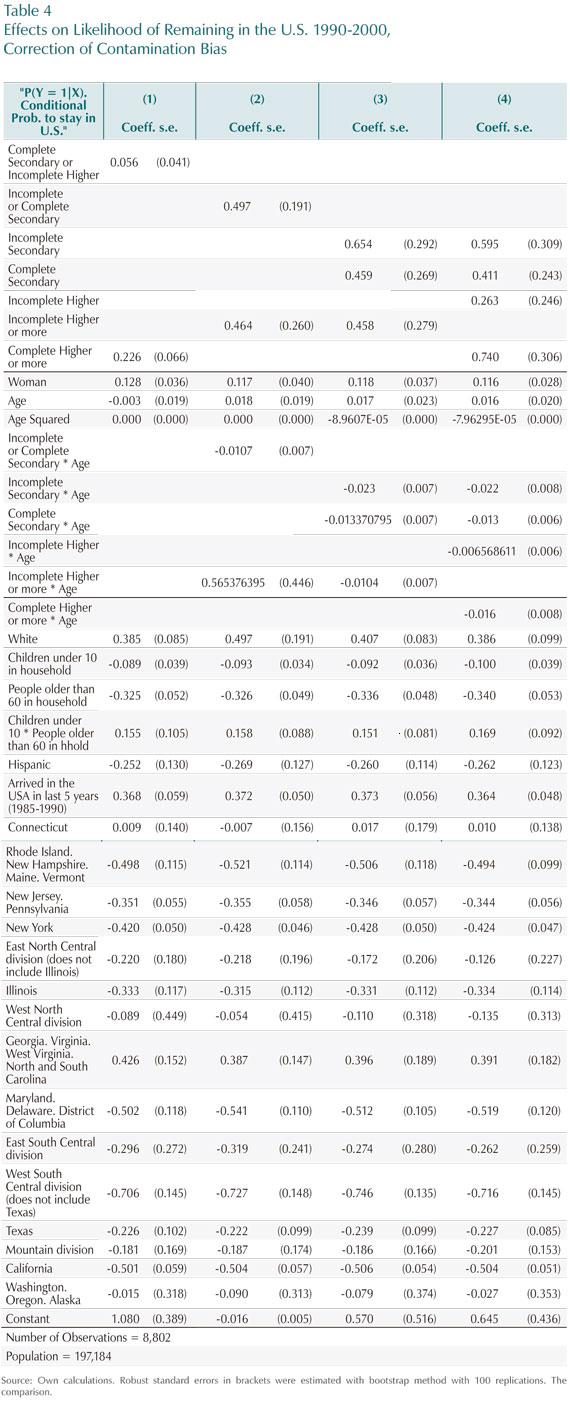
When one introduces interactions between educational dummies and the age variable (see Table 4, models 2, 3 and 4), the results suggest that part of the effect found initially could be explained by the educational process of migrants in the U.S. However, the magnitude does not manage to alter the initial result; but rather, it maintains consistency once both coefficients are weighted one against the other (the net effect) 23. Also, the effect's solidity is verified by the results of the exercise that was carried out on the population between the ages of 35 and 55 in 1990, in which case the conclusions did not vary. In the particular case of people with a university degree or more, the coefficient is 19.8%. The above results are consistent with the presence of "positive selection" (as expounded by Borjas and Bratsberg, 1996), in the case of Colombian migrants in the United States.
Results on the basis of surveys in 2000 and 2005 are consistent with the above results (See Table 5), although the effect of education is more noticeable. This indicates that the phenomenon of exporting educated Colombians to the United States would seem to be of a structural nature.
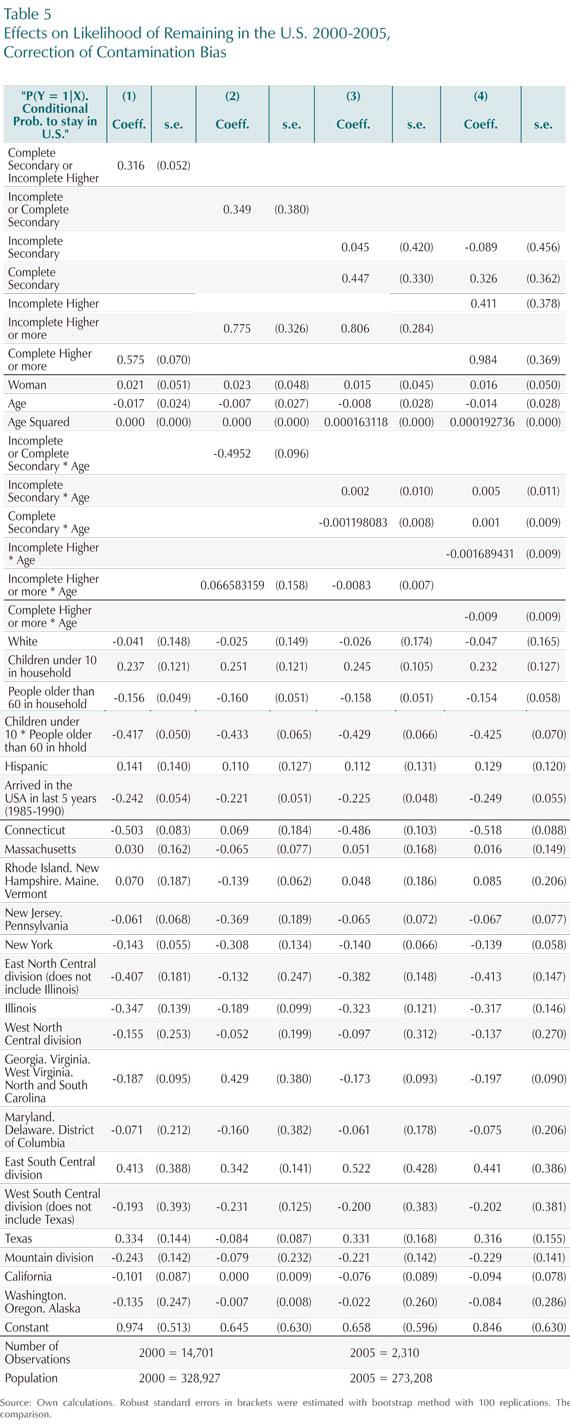
Some additional results for data supplied in 1990 and 2000 show that women are more likely to remain in the U.S. However, if they have children under ten years old or adults over sixty years old at home, the likelihood of their remaining in the U.S. is lessened. Those who have arrived in the U.S. recently (that is, in the last five years) are more likely to stay. For the period that goes from 2000 to 2005, the meaning of some of these variables changes. For example, the gender effect is no longer statistically significant. Having children under ten years of age increases the likelihood of remaining in the U.S., and those who arrived after 1999 are less likely to remain in the United States. This last observation may reflect the effects of the 1999 crisis in Colombia, which could have altered the Colombians' normal migration pattern.
Also, results for the period 1990 to 2000 show that, in the following regions - the States of Massachusetts (-0.311); Rhode Island, New Hampshire, Maine, Vermont (-0.49); New Jersey, Pennsylvania (-0.35); New York (-0.42); Illinois (-0.33); Maryland. Delaware, District of Columbia (-0.50); West South Central division, not including Texas (-0.70); Texas (-0.22) and California (-0.50) - there exists a negative and statistically significant effect when compared with Florida, Georgia, Virginia, West Virginia, North and South Carolina, where one finds a positive and statistically significant effect. This latter result could be associated with the fact that on the south-east coast, from Florida on, there is a considerable presence of Colombians. Map 1 (see Appendix) shows the zones of greatest presence of Colombians.
Medina and Posso (2009) present an application for the case of considering South America as a whole. Graph 3 shows a comparison between the results of Colombia and South America. In this case, the conclusions for South America are the same as for Colombia.
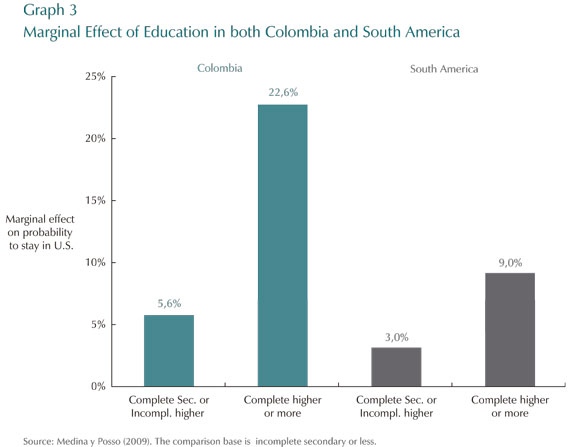
V. JOBS EMPLOYING FOREIGNERS IN THE UNITED STATES BY LEVEL OF EDUCATION
Evidence provided in the previous section points out, therefore, beyond any doubt, that a good level of education is an important determining factor in a Colombian migrant's decision to remain in the United States. On the other hand, the benefits that countries obtain when their emigrants return home depends -to a large extent- on the sorts of jobs that these same people had been working at while they were abroad; especially in such activities that they will have acquired knowledge and skills which may be used to advantage in their countries of origin (spillovers). In this sense, it is fundamental that we assess what are the determining factors that enable migrants to work in tasks which will generate the greatest personal and social benefits. It is especially important to determine whether or not education contributes to enhancing the possibilities of the migrant's gaining employment in tasks which lead to obtaining further knowledge and greater satisfaction.
In order to better understand what motivates migrants to remain in the United States, we proceed to explore the relation which exists between the migrants' levels of education and the level of complexity of the tasks which these same migrants find in their jobs or places of employment. We begin by analyzing descriptive statistics of the complexity of the tasks that migrants perform conditional on their education levels24.
Graph 4 illustrates the relationship between the education level and the task intensities for the two tasks -the least complex, "Manual" or "ehf", and the most complex, "Math" (Autor, Levy and Murnane, 2003)- for Colombia and the aggregate of the top ranked countries in the Math task intensity (see Appendix, Table 3). Let us keep in mind that each occupation has a level of intensity for each of the five possible tasks adopted, thus a higher level of intensity in one specific column implies that migrants are more likely to be in occupations that are more intensive in that task. Both axes (left Manual and right Math) show a close relationship between education and task intensity, decreasing with education in Manual and increasing in Math.
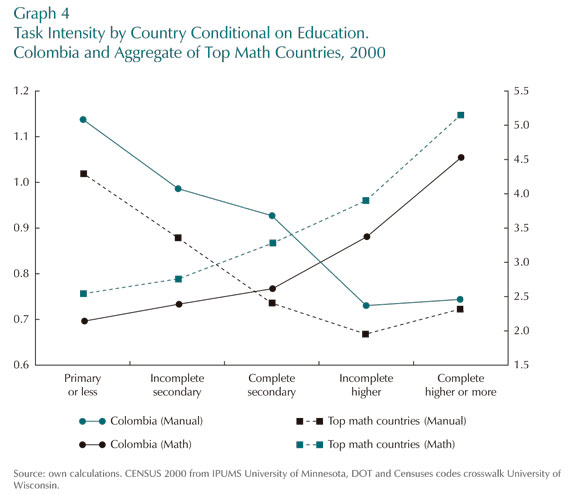
Nonetheless, there are differences between countries: Migrants from the Top Math countries have lower levels of intensities in the Manual task and higher in the Math task. However, the trend in both cases is the same; especially, this Graph shows that Colombia's most skilled population has low intensity on manual tasks -similar to that for people from the Top Math countries. Notwithstanding, Colombian immigrants in the U.S. lag in the Math task intensities, even when there is controlling for education.
In order to assess whether or not there exists an important mismatch between educational levels and tasks´ complexities. Graph 4 shows the distribution of Manual and Math tasks by educational level of migrants from Colombia and the top ranked countries in their Math task intensity. The graph shows that there is actually a share of educated migrants in each country with incomplete higher education or more, that are misplaced in occupations with some amount of Manual task intensity; nonetheless, the vast majority of them has no Manual task dedication. It is true though that it is less likely for an educated migrant of the denominated "Top Countries" to be working in an occupation with any amount of Manual task intensity than it is for any average Colombian.
On the other hand, while the distribution across Math task intensities is very similar for Colombians, they clearly have more weight on their right for the cases of the migrants of the Top Countries.
In short, Graph 5 presents a picture much less dramatic than what has previously been presented in terms of skilled Colombians commonly performing low- skilled tasks. For example, the work developed by Ozden (2006) used, as we do, the 2000 U.S. Census data to show that only 42 percent of Colombian migrants in the U.S. with a bachelor´s degree work in skilled jobs; while Graph 5 shows that only a small share of them work in activities with low levels of Math task intensities -yet most of them perform tasks with no Manual intensity at all. Ozden's definition leads him to conclude that for Taiwan, Iran and Nigeria- countries that are included in our "Top Countries"- only 46, 34 and 40 percent (respectively) of their migrants with a bachelor´s degree work in skilled jobs, at levels at, or below, those for Colombians.
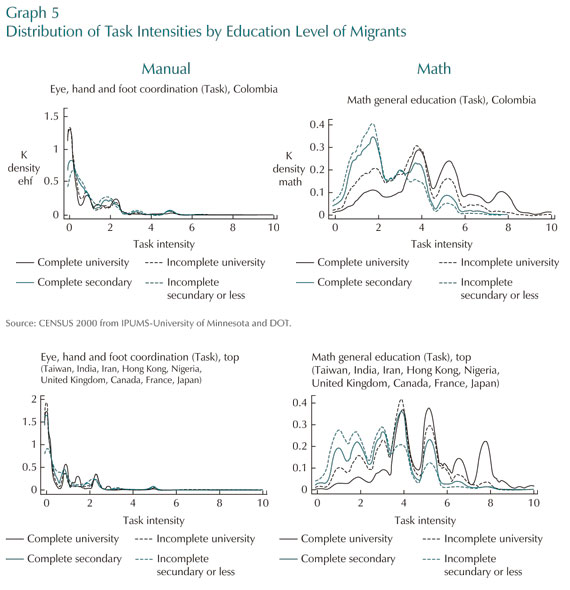
The difference between these results should be explained by the way skilled jobs are defined in Ozden's paper. According to his definition, a skilled job is that in which the average education needed for that occupation is, at least, 16 years. That definition is very likely to misclassify several migrants with a bachelor´s degree who perform a complex task; nonetheless, it works with peers whose average accumulated education is less than 16 years. Despite these differences in the magnitude of the mismatches between education and job quality of migrants. Ozden's conclusions and ours point in the same direction: Colombian migrants have a poor performance in the U.S. labor market in relation to migrants from developing countries in Asia, and from developed countries.
We now proceed to build a model in which the intensity of each of the five tasks under consideration is explained through its relation with variables associated with the amount of human capital that a person has, and the variables which determine his or her decision to participate, or not, in the labor market; and implicitly, to choose from among the different kinds of employment available. The model is the following:

Where Yji is the intensity of the task j carried out by migrant i. Our variable of interest is the level of education. Nonetheless, our estimation includes some socio-economic variables as controls.
Table 6 presents the results of the model estimated (Equation 7) on the basis of the United States population census of Colombian migrants in the year 2000. The results conclusively refute the idea that Colombian migrants are systematically employed in jobs for which they are over qualified. In fact, Colombians with a university education (or more) are less likely to be systematically employed in manual labor, and are more likely to find work which requires analytical and cognitive skills. Medina y Posso (2009), using the same estimation and data, argue that migrants from Argentina, Bolivia, Chile, Uruguay and Venezuela are employed in activities relatively more intense in cognitive, non-routine analytical tasks, than the Colombians. The only countries whose migrants are employed on average with less intensity than the Colombians in these kinds of jobs are those from Ecuador and Peru.
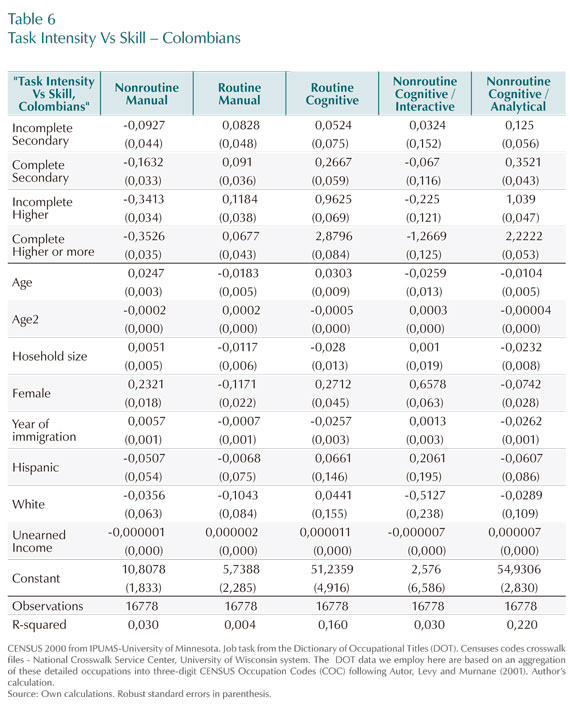
To sum up, the results indicate that the belief that Colombian professionals are employed in the United States in poorly qualified jobs -that is, in jobs unrelated to their level of qualification - is no more than a popular myth- or at least, not true for the average emigrant.
VI. CONCLUSIONS
Colombia is engaged in a process of net exportation of those members of its population that have university or post-graduate degrees, while some other countries in the region are net importers of well qualified people. Also, the estimations provided in this article enable us to conclude that the flight of human capital (brain drain) is being accentuated by the "negative selection" of the returnees; in other words, by the fact that the Colombians who are most likely to leave the United States and return to Colombia are the less well-educated from among the migrants in that country. Although it is true that certain countries in the region are net importers of highly qualified personnel. South American countries, taken as a whole, suffer from the phenomenon of "negative selection" of their returnees, albeit to a lesser degree than Colombia. Colombians in the United States who are university graduates or post-graduates are 22.6% more likely to remain in the U.S. than those who have only secondary education or less.
The fact that the exercise has produced consistent results for the period 1990-2000, and also for the years between 2000 and 2005, and bearing in mind that the former period included the economic crisis which Colombia suffered towards the end of the 1990´s -whereas during the latter period the country underwent a process of economic recovery- the results would suggest that over and above short-term considerations and contingencies, the "negative selection" tendency of the returnees is a structural phenomenon that will continue to contribute to the flight of human capital. at least in the medium-term.
Also, the results show that Colombians in the U.S., with a university education (or more), are less likely to be systematically employed in manual labor, and are more likely to find work that requires analytical and cognitive skills. In closing, this indicates that the belief that Colombian professionals are employed in the United States in poorly qualified jobs is not true for the average skilled emigrant.
Comentarios
1 The figures of Colombians abroad and those living in the United States are a result of various assumptions discussed below, while the figures on South Americans living in the United States are estimated using the 2005 U.S. Census.
2 The periods define the moment when the migrants arrived in the United States.
3 The "brain drain" is also known as "human capital flight" and is understood as the emigration of highly qualified individuals.
4 Cárdenas and Mejía (2006) base their estimate on figures supplied by Colombia's Foreign Affairs Ministry.
5 These calculations are based on data from the 2005 CENSUS for Colombia and a sample from CENSUS of 1% for the United States. Both data bases were provided by the Integrated Public Use Microdata Series International - IPUMS International. The graphs demonstrate the components of completed university courses or more and primary education or less, according to age. These calculations are based on data from the 2005 CENSUS for Colombia and a sample from CENSUS of 1% for the United States. Both data bases were provided by the Integrated Public Use Microdata Series International - IPUMS International. The graphs demonstrate the components of completed university courses or more and primary education or less, according to age.
6 It can be found on a Colombian media company's website. See http://www.caracol.com.co/nota.aspx?id=476144
7 These Tables were drawn up using the U.S. CENSUS for 2005 (CENSUS sample of 1%) and 2000. The two data bases were obtained from IPUMS. The graphs show the share of complete university education (or higher) and university incomplete (or more) for those employed between 25 and 55 years of age.
8 Peri and Sparber (2008, 2009) also use the DOT data to look for complementarities among low educated Americans and migrants, while previous work by used as proxy of the level of complexity of the tasks by the average education in the occupations.
9 Following the methodology of Autor et al., (2003), we estimate in what kind of employment foreigners in the United States are working, on average: whether analytical, routine or manual. The Table presents only those countries which had at least 100,000 migrants in the U.S. in the year 2000 and are ordered in accordance with a category known as "Nonroutine Cognitive/Analytical" which is related to employed people who have a high intensity in tasks associated with work which contains a high analytical component, in areas such as engineering, mathematics, economics, finances, etc. (which are not operative tasks).
10 Examples on the type of work can be found in Autor et al., (2003), Table 1 in the Appendix.
11 http://www.colombianosenelexterior.com/index.php?
12 A house-to-house survey carried out by Colombia's National Statistics Department (DANE) in 2004 for the Central West Metropolitan Area (AMCO for its initials in Spanish). This survey covered the city of Pereira and the municipalities of Dosquebradas and La Virginia.
13 This exercise, however, is hindered by a lack of census data because it only seeks out those Colombians in the U.S. who "stayed to tell the story", in this case both selection bias and contamination bias exist.
14 We use the Linear Probability Model (OLS) for our estimation. Amemiya (1981) argues that this model has worked very well for slope parameters if 0.1 ≤ p ≤ 0.9. In this case, the main assumption is that independent variables are normally distributed (Maddala, 1983; Cameron and Trivedi, 2005).
15 On the other hand, if we showed that task choices are highly related to migrants‘ education, then we would have at least partially accounted for the task dimension in the empirical model by having included education. This point will be developed in Section V.
16 Our main data source is the Integrated Public Use Microdata Series International - IPUMS International (see https://international.ipums.org/international/).
17 In fact, they are individuals who decide to leave the U.S., although the most likely to return to Colombia.
18 See Heckman and Robb (1985), pp. 184-185, assumptions A-6 and A-7.
19 Note that in this case Y is a binary variable, then Y0 is a vector filled with zeros.
20 Estimates are based on migration reports by Colombia's Security Department (DAS).
21 In this case, the model is called the Linear Probability Model.
22 The table shows the results of biased calculations using OLS so that they may be directly comparable with the results of estimates that correct the bias. Nonetheless, the biased estimates were calculated on the Logit and Probit models, arriving at results very like those of OLS.
23 Assuming that the average age is 35 years, the net effect would be 17.4%.
24 We use information provided by Autor et al., (2003) who classify the task in five: (1) Nonroutine Manual (ehf), (2) Routine Manual (finger), (3) Routine Cognitive (sts), Nonroutine Cognitive/Interactive (dcp), Nonroutine Cognitive/Analytical (math).
REFERENCES
1. Ahmed, B.; Robinson, J. "Estimates of Emigration of the Foreign-born Population: 1980-1990", Population Division Working Paper, num. 9, U.S. Census Bureau, 1994. [ Links ]
2. Amemiya, T. "Qualitative Response Models: A Survey", Journal of Economic Literature, pp. 1483-1536, 1981. [ Links ]
3. Autor, D.; Levy, F; Murnane. R. "The Skill Content of Recent Technological Change: An empirical exploration", Quarterly Journal of Economics, November 2003, vol. 118. num, 4. pp. 1279-1333, 2003. [ Links ]
4. Borjas, G. J. "Self-Selection and the Earnings of Migrants", The American Economic Review, vol. 77, num. 4, 531-553, 1987. [ Links ]
5. Borjas, G. J. "The Economics of Immigration". Journal of Economic Literature, vol. 32, num. 4, 1667-1717, 1994. [ Links ]
6. Borjas, G. J.; Bratsberg, B. "Who Leaves? The Outmigration of the Foreign-Born", The Review of Economics and Statistics, vol. 78, num. 1, pp. 165-176, 1996. [ Links ]
7. Cameron, C.; Trivedi, P. Microeconometrics: Methods and Applications. Cambridge University Press, New York, 2005. [ Links ]
8. Cárdenas, M.; Mejía C. "Migraciones internacionales en Colombia: ¿qué sabemos?", Documentos de Trabajo de Fedesarrollo, núm. 30, 2006. [ Links ]
9. Cassarino, J. P. "Theorising Return Migration: The Conceptual Approach to Return Migrants Revisited", International Journal on Multicultural Societies, vol. 6, num. 2, pp. 253-279, 2004. [ Links ]
10. Garay, L.; Rodríguez, A. Estudio sobre Migración Internacional y Remesas en Colombia. Ministerio de Relaciones Exteriores de Colombia y Organización Internacional para las Migraciones, 2005. [ Links ]
11. Gaviria, A. "Visa USA: Fortunas y Extravíos de los Migrantes Colombianos en los Estados Unidos", Documento CEDE, núm. 17, Universidad de los Andes, 2004. [ Links ]
12. Gaviria, A.; Mejía. C. "Las varias caras de la diáspora: los nexos de los emigrantes colombianos con su país de origen", Documento CEDE, núm. 29, Universidad de los Andes. 2006. [ Links ]
13. Heckman, J.; Robb. R. "Alternative Methods for evaluating the impact of interventions" in J. Heckman and B. Singer, Longitudinal Analysis of Labor Market Data, Econometric Society Monograph 10, Cambridge University Press, 1985. [ Links ]
14.Maddala, G. Limited-Dependent and Qualitative Variables in Economics, Cambridge, UK, Cambridge University Press, 1983. [ Links ]
15. Medina, C. "Selección en Retornados y Selección en Migración: el Caso Colombiano" en Efectos de la Migración en Colombia, Debates de Coyuntura Social, núm. 24, Fedesarrollo, 2008. [ Links ]
16. Medina, C.; Cardona, L. "The Effects of Remittances on Household Consumption, Education Attendance and Living Standards: the Case of Colombia", Lecturas de Economía, Universidad de Antioquia, Departamento de Economía, Issue 72, pp. 11-44. [ Links ]
17. Medina, C.; Posso. C. "Colombian and South American Immigrants in the United States of America: Education Levels, Job Qualifications and the Decision to Go Back Home", Borradores de Economía, num. 572, Banco de la República de Colombia, 2009. [ Links ]
18. Ozden, C. "Educated Migrants: Is There Brain Waste?" in International Migration: Remittances and the Brain Drain, Edited by OZDEN, Caglar y Schiff, Maurice, World Bank, 2006. [ Links ]
19. Peri, G.; Sparber. C. "Task Specialization, Immigration, and Wages", American Economic Journal: Applied Economics, vol. 1, num. 3, pp. 135-69, 2009. [ Links ]
20. Peri, G.; Sparber, C. "Highly-Educated Immigrants and Native Occupational Choice", Discussion Paper Series, CDP No 13/08, Centre for Research and Analysis of Migration, 2008. [ Links ]
21.The Guardian "Brain gain' for India as elite return", Waching, April 21 2009. http://www.guardian.co.uk/world/2008/apr/20/india.globaleconomy?gusrc=rss & feed=networkfront, 2008. [ Links ]
22. Warren, R.; Passel, J. "A Count of the Uncountable: Estimates of Undocumented Aliens Counted in the 1980 United States Census", Demography, vol. 24, num. 3, pp. 375-393, 1987. [ Links ]
23. Warren, R.; Peck, J. "Foreign-Born Emigration from the United States. 1960-1970", Demography, vol. 17, num. 1, pp. 71-84, 1980. [ Links ]
